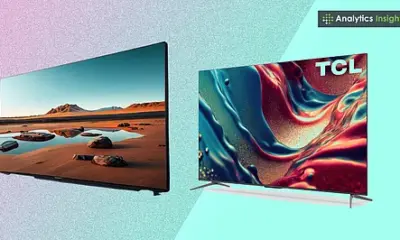Technology
OLED vs Micro-LED: The Battle for TV Technology Supremacy

The competition between OLED and Micro-LED technologies is shaping the future of television displays, raising questions about which will dominate the market in the coming decade. While OLED TVs have impressed consumers with their exceptional contrast and clarity for over a decade, Micro-LED technology is emerging as a formidable contender.
Understanding the Technologies
Both OLED and Micro-LED displays share a common strength: their ability to produce true black levels because each pixel is self-illuminating. OLED technology utilizes organic materials to achieve this effect, while Micro-LED employs microscopic LEDs without the need for a traditional backlight.
Micro-LED holds a significant advantage in terms of brightness. The brightest OLED TV tested in 2024, the LG G5, boasts peak brightness between 2,000 and 2,500 nits. In contrast, Micro-LED TVs can achieve peak brightness levels ranging from 4,000 to 5,000 nits, with some models rumored to exceed even that threshold. This superior brightness enhances picture quality and viewing experiences, making Micro-LED particularly appealing for bright environments.
Another critical benefit of Micro-LED technology is its resistance to burn-in, a common issue with OLED displays. Although modern OLED TVs come equipped with protective measures to mitigate burn-in, avoiding the problem altogether is a distinct advantage of Micro-LED.
Market Availability and Development Challenges
Despite its potential, Micro-LED technology is not widely available at present. The few models released, such as the upcoming 2024 Samsung Micro-LED TV, are often large, exceeding 100 inches and priced well above $100,000. The high manufacturing costs for smaller models limit accessibility, echoing the initial struggles faced by OLED technology about 15 years ago.
OLED has enjoyed a substantial head start, with prices significantly decreasing since its introduction. Various subtypes of OLED, such as quantum dot-enhanced models, offer enhanced performance, further solidifying OLED’s market position. The LG G5, for instance, incorporates fourth-generation OLED technology, delivering impressive brightness and color accuracy.
Nonetheless, Micro-LED’s benefits are noteworthy. As manufacturers like Samsung, Hisense, and Sony innovate new Mini-LED displays, they aim to bridge the gap between current offerings and future Micro-LED advancements. Samsung’s recent introduction of the “Samsung Micro RGB” illustrates the industry’s push toward this next generation of television technology.
The future remains uncertain, but the competition between OLED and Micro-LED will undoubtedly shape the television landscape for years to come. As consumers await more accessible options, the evolution of these technologies will be watched closely, with the potential for Micro-LED to emerge as the preferred choice for discerning viewers.
-

 Technology5 months ago
Technology5 months agoDiscover the Top 10 Calorie Counting Apps of 2025
-

 Technology3 weeks ago
Technology3 weeks agoOpenAI to Implement Age Verification for ChatGPT by December 2025
-

 Health3 months ago
Health3 months agoBella Hadid Shares Health Update After Treatment for Lyme Disease
-

 Health3 months ago
Health3 months agoAnalysts Project Stronger Growth for Apple’s iPhone 17 Lineup
-

 Health3 months ago
Health3 months agoErin Bates Shares Recovery Update Following Sepsis Complications
-

 Technology5 months ago
Technology5 months agoDiscover How to Reverse Image Search Using ChatGPT Effortlessly
-

 Technology3 months ago
Technology3 months agoElectric Moto Influencer Surronster Arrested in Tijuana
-

 Technology2 months ago
Technology2 months agoDiscover 2025’s Top GPUs for Exceptional 4K Gaming Performance
-

 Technology5 months ago
Technology5 months agoMeta Initiates $60B AI Data Center Expansion, Starting in Ohio
-

 Technology5 months ago
Technology5 months agoRecovering a Suspended TikTok Account: A Step-by-Step Guide
-

 Health5 months ago
Health5 months agoTested: Rab Firewall Mountain Jacket Survives Harsh Conditions
-

 Lifestyle5 months ago
Lifestyle5 months agoBelton Family Reunites After Daughter Survives Hill Country Floods





















